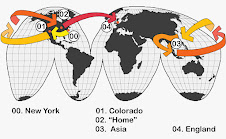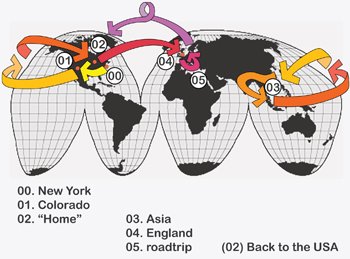
 I still remember the very first time I was given a site plan at work here. As I peered down at the drawing, I struggled to make sense of it. It seemed odd, this unfamiliarity with something that should have been completely legible to me, but I simply could not figure out what boundaries the lines were denoting: what was built and what was not, where the street began and the pavement/sidewalk ended , which square was house and which was garden/lawn. Obviously, I knew that things were different here, with towns and villages, as well as houses, typically more closely spaced. But that this difference would make me a useless employee for a few days, I had no idea.
I still remember the very first time I was given a site plan at work here. As I peered down at the drawing, I struggled to make sense of it. It seemed odd, this unfamiliarity with something that should have been completely legible to me, but I simply could not figure out what boundaries the lines were denoting: what was built and what was not, where the street began and the pavement/sidewalk ended , which square was house and which was garden/lawn. Obviously, I knew that things were different here, with towns and villages, as well as houses, typically more closely spaced. But that this difference would make me a useless employee for a few days, I had no idea.
Read the rest...
Now, well over a year later, I can make sense of a line drawing of a British street. A glance and I know which line in which color, dashed, solid, or dotted, indicates house, street, pavement, wall. I now suspect my confusion was partially due to unfamiliar architectural notation, but, more so, to simple cultural differences in spatial configuration. It's not that neighborhoods are planned differently here; they just are different. A line indicating a property boundary is more than likely something physical like a fence or hedge. Two boxes next to each other are probably two buildings with one shared wall. In fact, the average English home will have a tiny front yard, a larger, completely fenced in back yard, and probably one or more party walls. I think semi-detacheds (what we might call a duplex) are more common than detacheds (what we might call a house). And then there are the rows and rows of terraced houses, townhouses or rowhouses, I think we'd call them. (This image is of Newcastle.) Josh and I had been told our house was large before we first visited it, but new to the country, I was surprised to find a terraced house standing at the given address, surprised that a terraced house could be included in the “large” category. It can. Terraced houses can be massive or miniscule, and they are found in big cities, tiny villages and all densities of habitation in between. The English grew up in and around houses with shared walls, so they're just not as strange as they probably are to most Americans. One commonality between the British and the Americans, though, is the desire to own rather than rent a home. People at work talk about other Europeans as willing to live in apartments and/or rent houses, but the English would rather pay a mortgage on a house. I think the same is true in the United States... we just assume our mortgage buys us our own four walls.
And then there are the rows and rows of terraced houses, townhouses or rowhouses, I think we'd call them. (This image is of Newcastle.) Josh and I had been told our house was large before we first visited it, but new to the country, I was surprised to find a terraced house standing at the given address, surprised that a terraced house could be included in the “large” category. It can. Terraced houses can be massive or miniscule, and they are found in big cities, tiny villages and all densities of habitation in between. The English grew up in and around houses with shared walls, so they're just not as strange as they probably are to most Americans. One commonality between the British and the Americans, though, is the desire to own rather than rent a home. People at work talk about other Europeans as willing to live in apartments and/or rent houses, but the English would rather pay a mortgage on a house. I think the same is true in the United States... we just assume our mortgage buys us our own four walls.
 With all the houses clustered together, the landscape simply looks different here. Habitation comes in clumps and clots, often allowing for more green space closer to the center of cities. Imagine a school gymnasium full of people who barely know each other. They’ll probably stay fairly spread out, perhaps like marbles on an even surface, and the gym will more or less feel full. Now make the surface a little less even by putting in, say, a few tables of food. The people will cluster around the tables just as marbles will bunch together in any dips and cracks, leaving more space feeling unoccupied. This satellite image of a part of Newcastle shows such uneven settlement with its semi-detached houses, terraced housing, some allotment gardens- the type where you get your own 10'x10' plot to tend- and cow pasture. I suppose I should note that open space in Britain does not mean wild space. The green here is still developed; it's just gardens or farmland. Josh has commented before on the lack of what we'd consider truly open space or wilderness.
With all the houses clustered together, the landscape simply looks different here. Habitation comes in clumps and clots, often allowing for more green space closer to the center of cities. Imagine a school gymnasium full of people who barely know each other. They’ll probably stay fairly spread out, perhaps like marbles on an even surface, and the gym will more or less feel full. Now make the surface a little less even by putting in, say, a few tables of food. The people will cluster around the tables just as marbles will bunch together in any dips and cracks, leaving more space feeling unoccupied. This satellite image of a part of Newcastle shows such uneven settlement with its semi-detached houses, terraced housing, some allotment gardens- the type where you get your own 10'x10' plot to tend- and cow pasture. I suppose I should note that open space in Britain does not mean wild space. The green here is still developed; it's just gardens or farmland. Josh has commented before on the lack of what we'd consider truly open space or wilderness.
Honestly, though, I think this makes the British countryside more interesting. Sameness has its beauty and its place, but diversity can be intriguing. Most people will choose a painting with a variety of colors and shapes over a monochromatic color field; there’s something about the push and pull, the tension of difference, that appeals to us.

The car, you say? That’s the culprit? Perhaps. And perhaps Americans will never be happy sharing walls or giving up some private space for public use, but surely we can be sensible about what and where we build. Surely Americans are known for their ingenuity- we haven’t dug ourselves into a hole we can’t climb back out of or, at the very least, turn into a community swimming pool.
(I hate it when people point out problems or irritations without offering solutions. Sorry. This is a typically light-hearted blog, and the post has gone on long enough... so I will be my own pet peeve!)
Thursday, March 19, 2009
Open space
Posted by
megfeen
at
8:55 AM
![]()
Subscribe to:
Post Comments (Atom)


2 comments:
'An Englishman's home is his castle' so the saying goes, a big fence is just a way to communicate that this is your space and it's private- you can only come in if I want you to, that kind of thing.
American development (in the vast quantaties I've seen of it (!) ) looks like it tends to be planned a lot better, in neat rows whereas english places on the whole kind of grew as people filled in the gaps with more houses. Apart from the two-up-two-down towns that were connected to an industry- those came about faster as it was necessary to fit a large group into a town space and those places are in neater rows.
I do like that about England, it's higgledly-piggeldy-doesn't-really-match-ness.
And thats my two cents :)
ps I like how Liverpool is becoming a regular feature on the blog ;)
No doubt, the car is the culprit. American cities with any kind of density (like New York or Charleston) were largely developed before the automobile, or with a deliberate plan for new urbanism(Portland or Seattle).
The solution, therefore, is for enough people to intentionally give up ownership of a car. You can do it now and have time to adjust or do it later when high gas prices bankrupt the rest of us.
Post a Comment